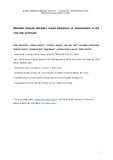JavaScript is disabled for your browser. Some features of this site may not work without it.
| dc.contributor.author | Bourhane, Zeina | |
| dc.contributor.author | Lanzén, Anders | |
| dc.contributor.author | Cagnon, Christine | |
| dc.contributor.author | Atai, Emmanuel | |
| dc.contributor.author | Borja, Angel | |
| dc.contributor.author | Cravo-Laureau, Cristiana | |
| dc.contributor.author | Duran, Robert | |
| dc.date.accessioned | 2021-08-12T13:57:49Z | |
| dc.date.available | 2021-08-12T13:57:49Z | |
| dc.date.issued | 2021-07-31 | |
| dc.identifier.citation | Bourhane Z, Lanzén A, Cagnon C, et al., (2022) Microbial diversity alteration reveals biomarkers of contamination in soil-river-lake continuum. Journal of Hazardous Materials, Volume 421, January 2022, Article number 126789 | en_UK |
| dc.identifier.issn | 0304-3894 | |
| dc.identifier.uri | https://doi.org/10.1016/j.jhazmat.2021.126789 | |
| dc.identifier.uri | http://dspace.lib.cranfield.ac.uk/handle/1826/16990 | |
| dc.description.abstract | Microbial communities inhabiting soil-water-sediment continuum in coastal areas provide important ecosystem services. Their adaptation in response to environmental stressors, particularly mitigating the impact of pollutants discharged from human activities, has been considered for the development of microbial biomonitoring tools, but their use is still in the infancy. Here, chemical and molecular (16S rRNA gene metabarcoding) approaches were combined in order to determine the impact of pollutants on microbial assemblages inhabiting the aquatic network of a soil-water-sediment continuum around the Ichkeul Lake (Tunisia), an area highly impacted by human activities. Samples were collected within the soil-river-lake continuum at three stations in dry (summer) and wet (winter) seasons. The contaminant pressure index (PI), which integrates Polycyclic aromatic hydrocarbons (PAHs), alkanes, Organochlorine pesticides (OCPs) and metal contents, and the microbial pressure index microgAMBI, based on bacterial community structure, showed significant correlation with contamination level and differences between seasons. The comparison of prokaryotic communities further revealed specific assemblages for soil, river and lake sediments. Correlation analyses identified potential "specialist" genera for the different compartments, whose abundances were correlated with the pollutant type found. Additionally, PICRUSt analysis revealed the metabolic potential for pollutant transformation or degradation of the identified "specialist" species, providing information to estimate the recovery capacity of the ecosystem. Such findings offer the possibility to define a relevant set of microbial indicators for assessing the effects of human activities on aquatic ecosystems. Microbial indicators, including the detection of “specialist” and sensitive taxa, and their functional capacity, might be useful, in combination with integrative microbial indices, to constitute accurate biomonitoring tools for the management and restoration of complex coastal aquatic systems. | en_UK |
| dc.language.iso | en | en_UK |
| dc.publisher | Elsevier | en_UK |
| dc.rights | Attribution-NonCommercial-NoDerivatives 4.0 International | * |
| dc.rights.uri | http://creativecommons.org/licenses/by-nc-nd/4.0/ | * |
| dc.subject | Functional potential | en_UK |
| dc.subject | Community structure | en_UK |
| dc.subject | Microbial ecology | en_UK |
| dc.subject | Environmental monitoring | en_UK |
| dc.subject | Environmental pollution | en_UK |
| dc.subject | Aquatic ecosystems | en_UK |
| dc.title | Microbial diversity alteration reveals biomarkers of contamination in soil-river-lake continuum | en_UK |
| dc.type | Article | en_UK |
Files in this item
The following license files are associated with this item:
This item appears in the following Collection(s)
-
Staff publications (SWEE) [2827]

